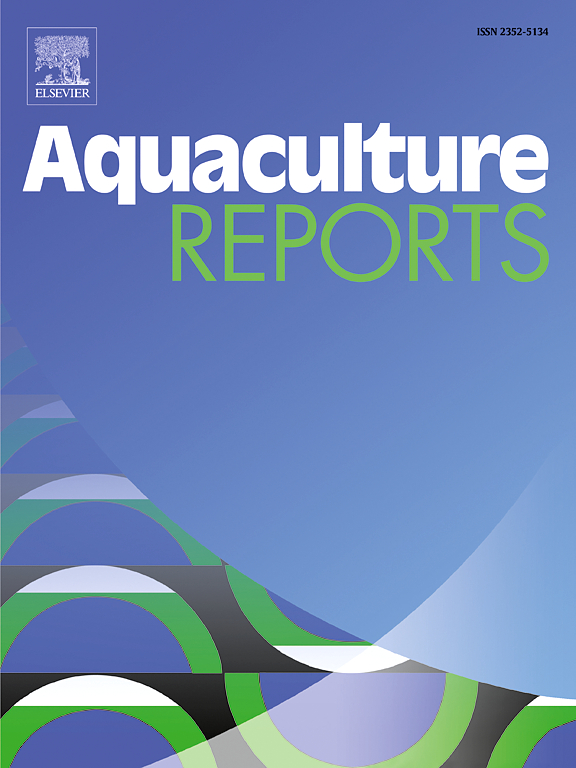低鱼粉饲料中添加南极磷虾粉对大西洋鲑鱼生长、营养物质利用、鱼片品质和伤口愈合能力的影响
IF 3.2
2区 农林科学
Q1 FISHERIES
引用次数: 0
摘要
在过去几十年里,由于对鱼粉和陆生作物对养殖鱼类饲料中蛋白质和脂质贡献的生态和经济考虑,导致蛋白质和脂质的显著减少,因此开始对替代来源进行调查。海洋浮游动物,如南极磷虾,具有高水平的蛋白质、磷脂、必需的n-3 LC-PUFA (EPA和DHA)以及类胡萝卜素,如虾青素。在25周的时间里,用含有0、8和12 %南极磷虾粉(KM)的试验饲料喂养鲑鱼,量化鱼的各种生产特征以及它们对机械伤害的反应。在25周的饲养期内,大西洋鲑鱼的初始体重增加了300 %以上,饲喂8 %和12 % KM试验饲料的鲑鱼的条件因子、FCR、PER、饲料消化率和全身组成与饲喂0 %对照饲料的鲑鱼没有显著差异。然而,饲喂KM试验饲料的鱼能够保持对照组饲料喂养的鱼的高性能,但由于KM粉,植物蛋白含量减少了31% %,微量营养素添加剂减少了15% %,脂质补充剂减少了14% %,合成虾青素减少了4% %。此外,喂食12% % KM饲料的鲑鱼鱼片显示出明显更高的平均色素沉着水平(即黄色和红色),粗略成像显示,喂食12% % KM饲料的鱼受伤的皮肤与未受伤的皮肤相比,颜色/外观的变化明显更小,与对照组相比,这可能有利于大西洋鲑鱼产业减少色素沉着,而色素沉着通常会导致生产者代价高昂的评级下调。本文章由计算机程序翻译,如有差异,请以英文原文为准。
Effects of dietary inclusion of Antarctic krill (Euphausia superba) meal in low fishmeal diets on Atlantic salmon (Salmo salar L.) growth, nutrient utilization, fillet quality, and wound healing capacity
Ecological and economic concerns of fishmeal and terrestrial crop contributions to protein and lipid in the diets of cultured fish have resulted in significant reductions over the last few decades, initiating investigations into alternative sources. Marine zooplankton, such as Antarctic krill possess high levels of protein, phospholipid, essential n-3 LC-PUFA (EPA and DHA) as well as carotenoids like astaxanthin. Salmon were fed experimental diets containing 0, 8 and 12 % Antarctic krill meal (KM) over a 25-week period and quantified various production characteristics of the fish as well as their responses to mechanical wounding. Atlantic salmon gained over 300 % of their initial body weight over the 25-week feeding period and their Condition Factor, FCR, PER, diet digestibility and whole-body composition of fish receiving the 8 and 12 % KM test diets did not significantly differ from the 0 % control diet. However, fish fed KM test diets were able to maintain the high performance of the control diet fed fish, but with up to 31 % lower plant proteins, 15 % less micronutrient additives, 14 % lower lipid supplements, and 4 % less synthetic astaxanthin due to KM meal. In addition, salmon fillets showed a significantly higher mean level of pigmentation (i.e., yellow and red colouration) in fish fed the 12 % KM meal diet, and gross imaging showed wounded skin from fish fed 12 % KM had significantly less variation in colouration/appearance from unwounded skin, compared to control, which could be beneficial to the Atlantic salmon industry by reducing hyperpigmentation that often leads to costly downgrades for producers.
求助全文
通过发布文献求助,成功后即可免费获取论文全文。
去求助
来源期刊

Aquaculture Reports
Agricultural and Biological Sciences-Animal Science and Zoology
CiteScore
5.90
自引率
8.10%
发文量
469
审稿时长
77 days
期刊介绍:
Aquaculture Reports will publish original research papers and reviews documenting outstanding science with a regional context and focus, answering the need for high quality information on novel species, systems and regions in emerging areas of aquaculture research and development, such as integrated multi-trophic aquaculture, urban aquaculture, ornamental, unfed aquaculture, offshore aquaculture and others. Papers having industry research as priority and encompassing product development research or current industry practice are encouraged.
 求助内容:
求助内容: 应助结果提醒方式:
应助结果提醒方式:


